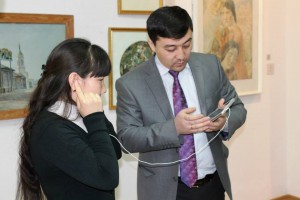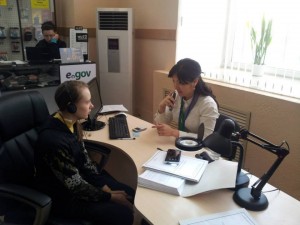 ASTANA – The United Nations Development Programme (UNDP) is working with the national government on a joint programme to improve the competitiveness of the East Kazakhstan region through the implementation of innovative approaches to the planning and delivery of social services.
ASTANA – The United Nations Development Programme (UNDP) is working with the national government on a joint programme to improve the competitiveness of the East Kazakhstan region through the implementation of innovative approaches to the planning and delivery of social services.
The programme covers projects intended to improve access to social and economic services for vulnerable groups in Semey, Kurchatov, Ust-Kamenogorsk and the most affected areas of the East Kazakhstan region, based on the example of the Semey area. It is financed by Kazakhstan’s small grants programme.
As part of their joint programme, several projects improving social and economic services and creating a barrier-free environment for people with disabilities and people with limited mobility have been implemented for the first time in the country.
One of the projects was the establishment of a Daytime Care Centre for elderly and disabled people. The purpose of the centre is to prevent overcrowding at elderly care homes and to provide medical and social services as well as a pleasant place for elderly and disabled people to spend their leisure time.
The centre is intended for 15 people, but there are plans to expand. It is equipped with a so-called sensor room with modern equipment including a massage chair, an oxygen concentrator and a rehabilitation compression trainer, which guests at the centre will be trained to use. The centre provides meals, access to a physiologist and classes with an exercise therapy instructor.
The project will facilitate a gradual transition from hospitals to an expanding network of organisations providing social services in daytime care institutions. The centre is one way of addressing the need for new, alternative forms of medical and social assistance aimed at improving quality of life. The centre was allocated 1.5 million tenge (about US$8,100) from programme funds.
A project in Semey, Theatre Without Barriers, creates an accessible environment for persons with disabilities by providing for audio and video descriptor and TV and audio equipment for broadcasting theatre events in sign language. This, incidentally, will also create jobs in the region. To further improve access, a modern roll-ramp was installed and a wheelchair for visitors with limited mobility purchased by the theatre. People with hearing disabilities will be able to attend the Abai Theatre in Semey and engage in the social and cultural life of the city more fully. On the day of presentation of the project, deaf and hearing-impaired visitors watched a play for the first time in their lives. The project was allocated 1,488,571 tenge (about US$8,050).
Museum Without Barriers, a 1.5 million tenge (about US$8,100) project, provided the opportunity for 12,000 disabled people in the Semey area who had suffered as a result of Soviet nuclear tests to get information about exhibits at the Nevzorovs East Kazakhstan Regional Museum of Fine Arts. The project developed special programmes for hearing-impaired people to be able to listen to presentations of museum exhibits. A film, “3D museum,” was created and will be broadcast on a special screen presenting paintings in sign language. The projects productions and programmes will be posted on the Nevzorovs museum website, which will be available for viewing at home for those who cannot visit the museum.
The Information Without Barriers project will be implemented in the Semey public service centre. Under the project, 661,245 tenge (about US$3,500) will be provided to create an area for people with special needs. A special table adapted for the disabled, a wheelchair and special equipment, including an amplifier for the hearing-impaired, an electronic magnifier for documents and a magnifier with a highlighter for the visually impaired, were purchased. The project is intended to improve access to key information, particularly about state services.
“Implementing projects like this will help test new, innovative mechanisms and implement international best practices for improving access to economic and social services. All projects are aimed at improving the delivery of social services. The implementation of these projects will also draw the attention of the public, nongovernmental organisations and media to solving social problems and will achieve long-term positive changes in society,” Project Manager Rauan Kaliyev explained. The projects will be implemented annually at state institutions.

